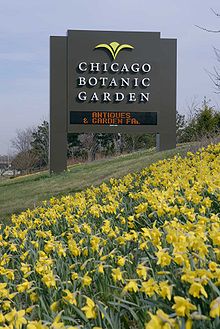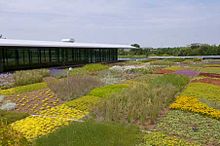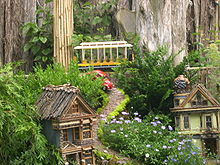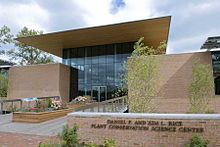- Chicago Botanic Garden
-
Located at 1000 Lake Cook Road, Glencoe, Illinois, USA, the Chicago Botanic Garden is a 385-acre (156 ha) living plant museum situated on nine islands featuring 24 display gardens and surrounded by four natural habitats: McDonald Woods, Dixon Prairie, Skokie River Corridor, and Lakes and Shores. The Garden is open every day of the year. Admission is free but parking is $20 per car; free for Garden members.[1]
The Chicago Botanic Garden is owned by the Forest Preserve District of Cook County and managed by the Chicago Horticultural Society. It opened to the public in 1972 and is home to the Joseph Regenstein, Jr. School of the Chicago Botanic Garden, offering a classes in plant science, landscape design and gardening arts. The Center for Teaching and Learning brings information on nature and plants to children, teens and teachers. Horticultural Therapy and Community Gardening provide community outreach and service programs. Through the Institutes of Plant Conservation and Ornamental Plant Research, Garden scientists work on plant conservation, research and environmental initiatives.
The Chicago Botanic Garden is accredited by the American Association of Museums and is a member of the American Public Gardens Association (APGA). In 2006, the Chicago Botanic Garden received the Award for Garden Excellence, given yearly by the APGA and Horticulture magazine to a public garden that exemplifies the highest standards of horticultural practices and has shown a commitment to supporting and demonstrating best gardening practices.
The mission of the Chicago Botanic Garden is to promote the enjoyment, understanding and conservation of plants and the natural world.
The Garden's website is http://www.chicagobotanic.org.
Contents
Garden Facts
The Chicago Botanic Garden is one of the United States' most visited public gardens and a center for learning and scientific research. Each year 760,000 people visit the Garden. It has a membership of 50,000, the largest of any U.S. public garden. More than 1,000 volunteers assist with all aspects of the Garden’s mission, from planting and propagating natural areas, to teaching educational programs and staffing public programs and exhibitions. The Chicago Botanic Garden is only one of 10 public gardens accredited by the American Association of Museums, recognizing its living collection of 2.4 million plants.
The 24 display gardens and four natural habitats include:
The Green Roof Garden - Located on top of the Daniel F. and Ada L. Rice Plant Conservation Science Center, the Ellis Goodman Family Foundation Green Roof Garden South features regional and national native plants, many of which are not currently used as rooftop plants; the Josephine P. & John J. Louis Foundation Green Roof Garden North features a mix of plants known as good green roof plants, plus native and exotic plants that have potential for green roof use. Generally, the plants are sun loving, drought tolerant, have a shallow root system, and can withstand windy conditions.
The Rainwater Glen and Footbridge - The Woman's Board of the Chicago Horticultural Society Rainwater Glen is a shallow, trough-like depression that surrounds the Plant Science Center. It functions like a river's floodplain and is designed to hold back stormwater runoff, allowing deep-rooted native plants to facilitate absorption and and help filter impurities. The Rainwater Glen will contribute to improved water quality at the Garden and, in each of the ecosystems in flows through.
The Aquatic Garden – This garden shows plants that grow in water through winding boardwalks over the lake. There are 31 varieties of water lilies and nine varieties of lotus in bloom during the summer and early fall. The plants are all hardy to the Chicago and Midwest.
The Bulb Garden – contains over 75,000 bulbs, including rare and unusual varieties.
The Circle Garden – This 18,000-square-foot (1,700 m2) garden displays annuals suited for a typical Midwest garden. At the center of the Circle Garden is afountain with 32 cascading plumes of water.
Dwarf Conifer Garden – This garden contains rare species such as one of the largest weeping Norway spruces in the Midwest, a 30-year-old thread leaf false cypress, and a Horstmann’s Silberlocke Korean fir. Work has begun on a redesign of the Dwarf Conifer Garden and is scheduled to re-open in June 2008.
Enabling Garden – This 11,000-square-foot (1,000 m2) garden shows structures, tools, techniques and programming to help people, of any age or ability, garden. The Enabling Garden features plantings that stimulate the senses, displays of adapted tools, hanging baskets on pulleys, vertical gardens that increase the ease of gardening, and planting beds and containers raised for comfortable reach.
English Walled Garden – Six English gardening styles are showcased in the English Walled Garden. This garden features more than 50,000 herbaceous and woody plants, with columns, fountains, runs and other garden ornamentation.
English Oak Meadow – Each year the English Oak Meadow features native and exotic annuals. The gently sloping hillside, with its fragrant annuals under a collection of oaks, serves as a natural division between the Dwarf Conifer and English Walled Gardens.
Esplanade – The 2.8-acre (1.1 ha) Esplanade is a new garden and plaza with public spaces and intimate areas. Its landscape provides a view of the Garden’s northernmost lake as well as fountains, waterspouts and pools.
Crescent Garden – Composed of concentric tiers shaped by hundreds of evergreen boxwoods, the Crescent Garden changes its planting beds every season.
Evening Island – Evening Island was designed in the “New American Garden” style to display the expanding horticultural collections of the Chicago Botanic Garden. The style is categorized by sweeping use of perennials and ornamental grasses. In the center of the island stands the Butz Memorial Carillon, whose tones signal the hour and provide summertime music.
Regenstein Fruit & Vegetable Garden – This is the largest display garden of its kind in the Midwest. The nearly 4-acre (1.6 ha) garden features displays, as well as education facilities and exhibits.
Greenhouses – There are Tropical, Semi-tropical and Arid. They feature 9,000 exotic plants with informational displays.
Heritage Garden – This garden provides visitors with an introduction to the history garden and plant nomenclature. It is a replica of Europe’s first botanic garden in Padua, Italy, and is divided into four quadrants each representing one of the four corners of the earth. The beds contain plant families ranging from the fern family (one of the least complex), to the aster family (one of the most complex). The focal point of the garden is a sculpture of Carl Linnaeus, the Swedish botanist and taxonomist known as “the father of botany.”
Lakeside Garden – The Lakeside Gardens cover a total of 2 ¼ acres and encircle the Great Basin Lake. They comprise a major collection of flowering trees, shrubs and perennials.
Landscape Gardens – This garden features eight garden styles and settings, to demonstrate how different types of landscape can thrive in Midwest gardens. It features the rock, traditional border, cool color/stream, ericaceous and easy-to-grow gardens, as well as the formal, informal and fragrant herb gardens.
Elizabeth Hubert Malott Japanese Garden – Also called Sansho-En (the Garden of Three Islands). It is designed in Japanese style with over 280 types of plants conducive to gardening in the Midwest. It is a four-season garden with curving paths and pruned trees, framing distant views of lakes, grassy hills, woods and gardens beyond. The three islands are Keiunto, Seifuto and Horaijima.
Mary Mix McDonald Woods – This is the Chicago Botanic Garden’s 100-acre (40 ha) naturally occurring oak woodland community of plants and animals, restored for the public to experience some of the native communities that once covered the Midwest. The woods include numerous plant communities such as wetland depressions, a small prairie remnant, a wooded moraine and savanna areas.
The Plant Evaluation Gardens (Sun and Shade) – The Chicago Botanic Garden staff evaluate more than 7,200 plants each year for bloom size, color, cold hardiness and disease and pest resistance. The results provide information and resources for the scientific and professional community, as well as for Midwest gardeners.
Suzanne S. Dixon Prairie – six prairies that represent the native prairies once common to northeastern Illinois, each with its own topography, soil conditions and native plant species:
- Black earth and plants taller than 8 feet (2.4 m) are characteristic of the tallgrass or mesic prairie that once dominated Illinois.
- The bur oak savanna is an open grassland prairie that incorporates clusters of native bur oak trees and the flowering plants growing around them.
- The sand prairie is a re-creation of the type of prairie found naturally at the southwestern end of Lake Michigan, where the shoreline encompasses low dunes with a marshy habitat sited between them.
- The steep, sloped gravel hill prairie is a dry, exceptionally well-drained area with slightly sandy or gravelly soil. Plants found here are lower to the ground and flower earlier than tallgrass varieties.
- The wet prairie is located close to the water’s edge and contains plants well suited to a marsh setting.
- The fen prairie is a re-creation of an unusual wetland where the water contains a high degree of mineral salts leached from underground limestone.
Native Plant Garden – This garden encompasses three areas: a woodland garden that displays native plants preferring part shade, from tall trees to spring ephemerals; a prairie garden, featuring sun-loving native prairie plants; and a habitat garden, which features native plants for bird and butterfly nesting and food sources.
Model Railroad Garden – This outdoor exhibition takes visitors from coast to coast with model trains, miniature representations of America’s best-loved landmarks, and small-scale gardens. The 7,500-square-foot (700 m2) Model Railroad Garden features 16 garden scale trains on 1,600 feet (490 m) of track. The buildings have been handcrafted with natural materials, including twigs, bark, leaves, acorns and pebbles. The landscape is made up of over 5,000 tiny trees, shrubs, groundcovers and flowering plants in 250 varieties. This garden is open from mid-May to late October.
Krasberg Rose Garden – Visitors entering this garden will see 50,000 plants representing 367 rose varieties, all hardy and well –suited for growing in the Chicago area. The only informal, free form rose garden of its kind in the United States, the collection is the largest in the Midwest.
Sensory Garden – This garden appeals to more than just the eyes with plantings of color, fragrance, form and texture. Visitors can touch the soft, fuzzy, silver-gray leaves of a lamb’s ear plant, enjoy the smell of a butterfly bush, and hear the distinctive rustle and pop of a saw tooth oak tree.
Skokie River – The Skokie River Corridor is a living laboratory to explore concepts of biodiversity, ecology, landscape and aesthetics. It is located along the western edge of the Chicago Botanic Garden, surrounding the one-mile (1.6 km) stretch of the Skokie River. The area includes 197 native plant species, all of local origin, growing in and along the river, including 32 sedge and 22 grass species.
Spider Island – This island offers a secluded space for contemplation, with dramatic water views. Ringed by birches, alders and serviceberries, a meadow of native plants, including bottlebrush grass, black-eyed Susan and purple coneflower, is at the heart of the garden. Along the islands shore grow 20 species of water plants such as blue flag iris, lizard’s tail and pickerelweed.
Water Gardens – The Water Gardens ring the Great Basin Lake and contain a major aquatic plant collection of 114,000 aquatic plants.
Waterfall Garden – This garden has 10–12 foot falls with water tumbling into small pools at the base of each drop. Paths and bridges enable visitors to walk to the top of the waterfall.
Bonsai Collection – This collection is regarded by bonsai experts as one of the best public collections in the world. It includes 200 bonsai in twenty-seven styles and more than 60 kinds of plants, including evergreen, deciduous, tropical, flowering and fruiting trees.
Daniel F. and Ada L. Rice Plant Conservation Science Center
The Chicago Botanic Garden opened the Daniel F. and Ada L. Rice Plant Conservation Science Center to the public on Wednesday, September 23, 2009 at the south end of the Garden. In September 2010, the Plant Science Center earned a GOLD LEED (Leadership in Energy and Environmental Design) rating from the U.S. Green Building Council because of its sustainable design. The rating system is based on points accumulated in six major categories, including sustainable sites, water efficiency, energy and atmosphere, materials and resources, indoor environmental quality, and innovation and design process. LEED standards increase initial building costs but decrease long-term operating expenses. By choosing to build this way, the Garden demonstrates its ongoing commitment to sustainable building and development practices.
The Plant Science Center provides laboratories and teaching facilities for more than 200 Ph.D. scientists, land managers, students, and interns whose research is critical to fulfilling the Garden’s efforts to save our planet by saving our plants. The 38,000-square-foot (3,500 m2) Plant Science Center also serves as home to a unique doctoral program in plant biology and conservation with Northwestern University and as headquarters for the Garden’s international efforts in plant conservation. A viewing gallery and the 16,000-square-foot (1,500 m2) Green Roof Garden are open to the public, giving nearly 800,000 visitors and schoolchildren each year the opportunity to view plant science firsthand.
The Garden’s 200 scientists address threats to endangered flora, train plant conservation leaders and research plant conservation policy. Programs and research focus on the collection, evaluation, introduction and preservation of plants within the context of threats such as climate change, global warming and human impacts.
The Chicago Botanic Garden conserves rare plant species, and is working with regional, national and international organizations on behalf of plant conservation. The Garden is a partner in the Seeds of Success project, a branch of the Millennium Seed Bank Project managed by the Royal Botanic Gardens, Kew. The goal is to collect 10,000 seeds from each of 1,500 native species of the Midwest for conservation and restoration efforts. The Garden is also a partner in the Plants of Concern initiative to monitor rare species in Northeastern Illinois.
The Garden is a member of Chicago Wilderness, a consortium of 200 local institutions dedicated to preserving and restoring Chicago’s natural areas, as well as the Center for Plant Conservation, a group of 30 other botanic gardens and arboreta committed to conserving rare plants from their region.
In trial and demonstration gardens, indoor greenhouses and laboratories located in the Daniel F. and Ada L. Rice Plant Resource Center, Garden horticulturists test plants to determine those that are best-suited for local gardens.
Joseph Regenstein, Jr., School of the Chicago Botanic Garden
An education program that began in 1990 as a series of classes for adult learners is now an academic institution offering 500 classes in subjects covering plants and people, gardening, nature and the environment, garden design and the botanical arts. In collaboration with universities, the Joseph Regenstein, Jr. School of the Chicago Botanic Garden now offers students degree accreditation; courses taught by scientists and teachers knowledgeable in the fields of plant biology, conservation and horticulture; and a 385-acre (156 ha) campus and field site.
Degree Programs offered at the School of the Chicago Botanic Garden:
L.E.A.P. Ph.D. Program – Landscapes, Ecological and Anthropogenic Processes (LEAP) is a Ph.D. program offered by the University of Illinois at Chicago in partnership with the Chicago Botanic Garden. Launched in 2005, the program fosters understanding of ecological processes in human-altered landscapes. The goal is to understand how human activities relate to the native species of plants and animals.
Northwestern University Masters Program – The Chicago Botanic Garden and Northwestern University have developed Master’s programs emphasizing plant conservation biology. This programs focuses on plant population biology, plant systematics, molecular biology, plant ecology, research design, invasive species, economic botany, ethics in biological research, plant population genetics, bioinformatics and soil ecology.
Masters Program in Natural Resources and Environmental Science – The University of Illinois at Urbana-Champaign, Department of Natural Resources and Environmental Sciences, has partnered with the Joseph Regenstein, Jr. School of the Chicago Botanic Garden to offer students graduate degrees in disciplines related to natural resources and environmental sciences. Areas of study include managing soil and water quality, urban forestry, resource ecology and human-landscape interactions.
University of Illinois at Urbana-Champaign Bachelor’s Program in Horticulture – The University’s College of Agricultural, Consumer and Environmental Sciences (ACES) and the Department of Natural Resources and Environmental Sciences (NRES), is partnering with the University’s Office of Continuing Education, Chicago area community and city colleges, The Morton Arboretum, the Chicago Botanic Garden and the Oak Brook Multi-University Center, in offering students the final years of coursework needed to complement their associate level courses and earn a Bachelor of Science in Horticulture. This is first horticultural bachelor’s program offered by either a private or public institution in the Chicago area.
World Environment Day
In 2008, the Chicago Botanic Garden was chosen by the United Nations Environment Programme (UNEP) as the sole North American host for World Environment Day with the theme, "CO2—Kick the Habit! Towards a Low Carbon Economy."
Over thirty non-profit, academic, cultural and environmental organizations participated in the "Knowledge and Action Marketplace" on the Garden's Esplanade. Displays and representatives discussed products to help green homes, local carpools, volunteer and community conservation programs, classes on green gardening, the use of CFL light bulbs, vehicles that run on used vegetable oil and even appliances that pop popcorn using solar energy.
Organizations participating in the event included the Center for Neighborhood Technology, offering car-sharing information; CNT Energy, working with ComEd to provide information about Watt Spot, a program to assist homeowners who want to pay market price for electricity. Northern Illinois Energy Project, provided free CFL bulbs. Chicago Wilderness and Openlands, provided information about local conservation and restoration programs and Horrigan Urban Forest Products highlighted the best uses for reclaimed wood from urban trees.
The Garden hosted its first International Climate Change Forum on that day, featuring national and international experts including Dr. Ashok Khosla, former Chairman on the UNEP; Fred Krupp, president of the Environmental Defense Fund; Mary Grade, former Regional Administrator for EPA region 5; Suzanne Malec-McKenna, Commissioner of the Department of the Environment for the City of Chicago; John Rowe, Chief Executive Officer of the Exelon Corporation; Arthur J. Gibson, Vice President of Environment, Health & Safety for Baxter International and Arthur Armishaw, Chief Technology and Services Officer for HSBC-North America.
Entries from UNEP’s International Children’s Painting Competition were exhibited throughout June at the greenhouse galleries, located in the Regenstein Center. More than 700 entries were received from which the first and second place North American winners were selected. Chicago-area and North American winners were featured.
On June 5 of each year the Garden and other venues around the world, highlight resources and initiatives that promote low carbon economies and lifestyles, such as improved energy efficiency, alternative energy sources, forest conservation, and eco-friendly consumption.
Digital Photography Contests
The Chicago Botanic Garden has held three seasonal amateur digital photography contests and is planning on holding them annually. Out of all submitted photographs, two grand prize winners, and first and second runners-up, and category winners will be selected and announced on the Garden's website. Photo categories includes Best Landscape, Best Close-Up, Best Wildlife, Best Friends of Family, Best Black and White, and Best Photo by a Contestant Under 18 Years of Age.
A photo gallery of the contest is updated each week so that all visitors to the Garden's website can see contestants' work. Winners will have their photographs featured on the Garden's website, which is seen by close to a million people each year. The grand prize winners will each receive complimentary one year memberships to the Chicago Botanic Garden.
PlantCollections.org
In June 2008, the Chicago Botanic Garden, in conjunction with 29 partners, launched PlantCollections.org[2], a gateway into a treasure trove of scientific information about the living plant collections at international botanic gardens and arboreta. The portal gives scientists a better understanding of the genetic diversity of plants around the world and plays an important international role in plant conservation. The project aims to provide access to the plant records of over 50,000 taxa contained in institutions around the world.
The Chicago Botanic Garden worked in conjunction with the North American Plant Collections Consortium (NAPCC), a program of the APGA, the University of Kansas Biodiversity Research Center and Natural History Museum, Morphbank at Florida State University School of Computational Sciences, Google Base, Beijing Botanical Garden, BG-BASE, Inc., BG-BASE (UK) Ltd. and Pathfinder Development with funding from the Institute of Museum and Library Sciences (IMLS) and private donors.
Participating institutions include the Arnold Arboretum of Harvard University, Beijing Botanical Garden, Chenshen Botanical Garden, Chicago Botanic Garden, Ganna Walska Lotusland, Huntington Art Collections, Library and Botanical Gardens, Landis Arboretum, Mt. Cuba Center Inc, Missouri Botanical Garden, Nanjing Sun Yat Sen Memorial Botanical Garden, Norfolk Botanical Garden, North Carolina Arboretum, San Francisco Botanical Garden, Santa Barbara Botanic Garden, Scott Arboretum of Swarthmore College, Shanghai Botanical Garden, The Morton Arboretum, UC Davis Arboretum, United States National Arboretum and University of Washington Botanic Gardens.
Coordinates: 42°8′54″N 87°47′24″W / 42.14833°N 87.79°W
Notes
See also
- List of botanical gardens in the United States
- List of Museums and Cultural Institutions in Chicago
- Morton Arboretum
- North American Plant Collections Consortium
External links
Categories:- Botanical gardens in Illinois
- Gene banks
- Glencoe, Illinois
- Visitor attractions in Cook County, Illinois
- Protected areas of Cook County, Illinois
- Greenhouses
- Buildings and structures in Cook County, Illinois
- Japanese gardens
- Institutions accredited by the American Association of Museums
Wikimedia Foundation. 2010.














